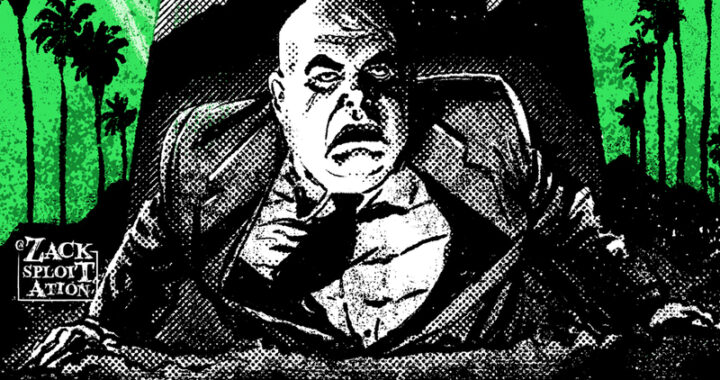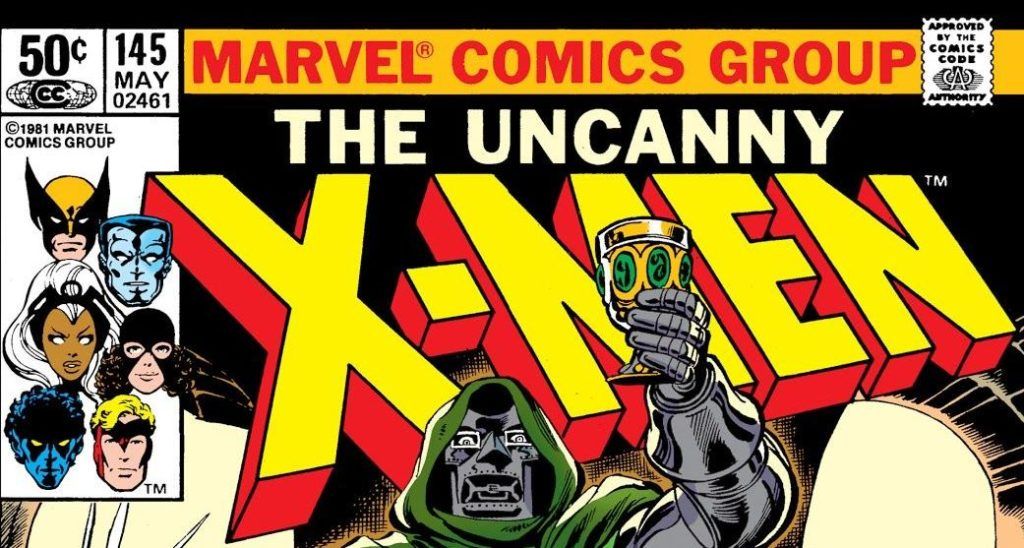
A Retrospective of Claremont’s X-Men, Part 7: “Everything Old Is New Again”
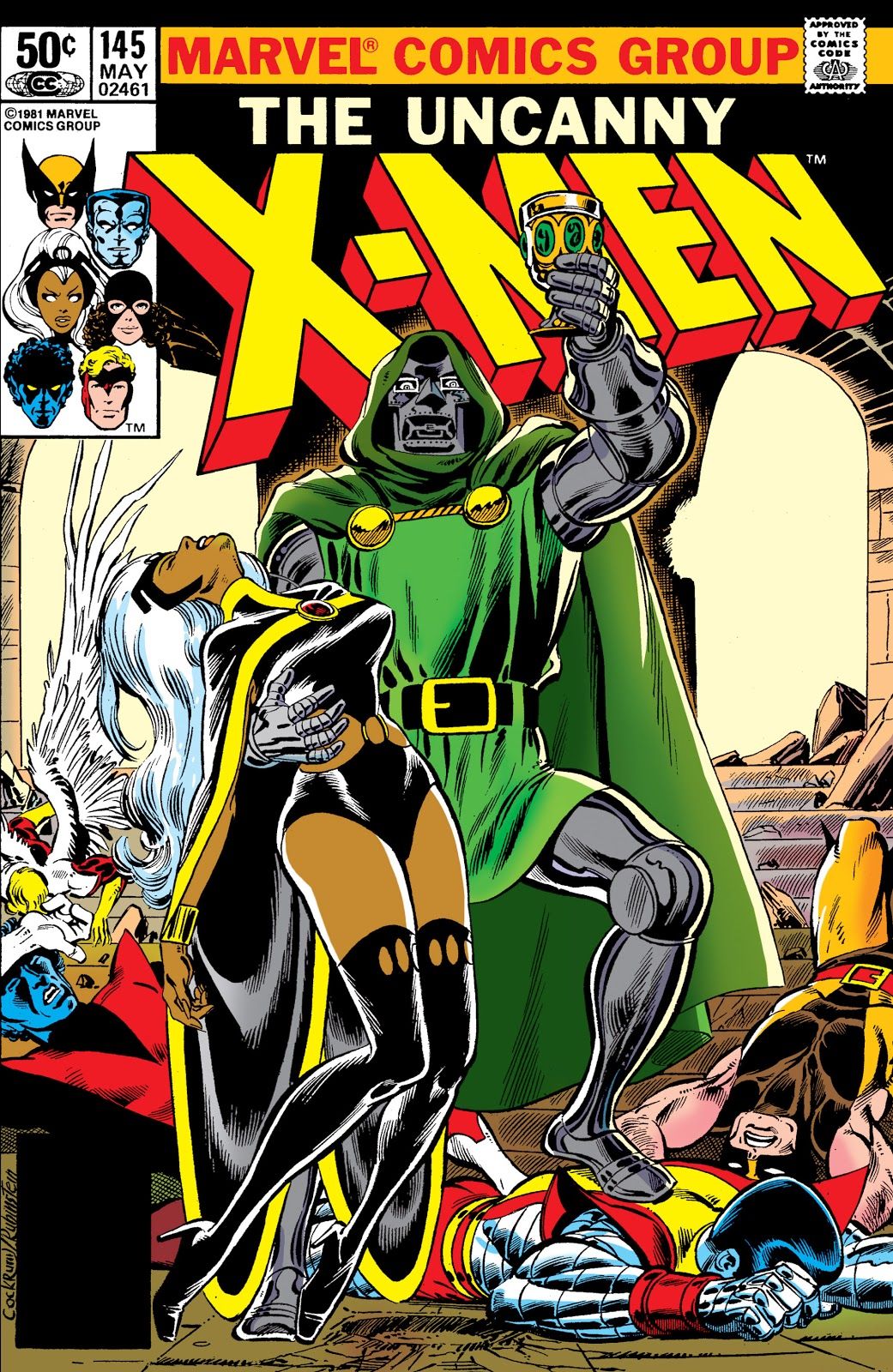 The end of the Chris Claremont/John Byrne era of Uncanny X-Men set up an interesting situation for the title after hitting arguably its creative summit. Byrne had left the book to move on to Fantastic Four, but as we will soon see, he still left an impact on the title in indirect ways. Still, there“s no question that the post-Byrne period was a rough patch for the book initially. Louise Jones (better known today as Louise Simonson) was still a relatively new editor, and the effects of the ending change to the Dark Phoenix Saga still left a mark on the book. Byrne had left remarkably large boots to fill, and that left a large question as to who would be best to replace him.
The end of the Chris Claremont/John Byrne era of Uncanny X-Men set up an interesting situation for the title after hitting arguably its creative summit. Byrne had left the book to move on to Fantastic Four, but as we will soon see, he still left an impact on the title in indirect ways. Still, there“s no question that the post-Byrne period was a rough patch for the book initially. Louise Jones (better known today as Louise Simonson) was still a relatively new editor, and the effects of the ending change to the Dark Phoenix Saga still left a mark on the book. Byrne had left remarkably large boots to fill, and that left a large question as to who would be best to replace him.
The answer came in the form of Dave Cockrum, Claremont“s first collaborator, who returned to do another stint on the characters he helped design. This may have been the wisest course, since Cockrum still had creative energy and ideas to contribute, in addition to a unique voice that defined the All-New, All-Different X-Men. His second run didn“t have the same impact as the first did, but he helped tell some excellent stories during his time on the book. This included some classic stories, such as the Magneto arc that began his shift from villain into tragic reformed hero. If nothing else, Cockrum offered stability and consistency, which the book needed in the wake of Byrne“s departure. He was also an artist that was a proven hand with Claremont, who usually played to the strengths of his artists.
Cockrum did not begin immediately, however, leading to a fill-in issue by Brent Anderson focusing on Cyclops. Today, Brent Anderson is perhaps best known for being the primary interior artist on Kurt Busiek“s Astro City, where he contributed to the entirety of the first run and a large part of the second. However, Anderson made his career in comics on the X-Men, and he would go on to do several issues in addition to the classic “God Loves, Man Kills”“ graphic novel.
When it came to the X-Men, Anderson often drew the horror-themed issues, and he delivered them successfully. It may be that Claremont, always aware of how best to use his artists, realized how well he was suited to horror. Alternately, it may be that Louise Simonson, no stranger to horror herself, saw a good opportunity and realized that Anderson would be a good fit for those stories. In any event, it proved to be the correct move, because Anderson does an effective job on what is essentially a Man-Thing story involving Cyclops.
On the surface, it might seem odd that Claremont would tell a one-off Man-Thing story in the pages of the X-Men. Still, Man-Thing is a character that Claremont had some familiarity with, having written the book for a time after Steve Gerber departed. Though Claremont doesn“t have the same level of biting social commentary or madcap ideas that Gerber brought, he captures the flavor of a proper Man-Thing tale reasonably well in this issue. It“s a story that“s told largely through narrative captions, since Claremont can“t convey the swamp creature“s true feelings with dialogue. Also, Man-Thing stories tend to play out around the Man-Thing, getting involved in the story only when it became dramatically necessary. Claremont grasped the conventions of that style of storytelling and did perhaps as well of a job as anyone aside from Steve Gerber possibly could have.
The other angle of this issue is that Claremont is still feeling out Cyclops“s role leading up to his plans to Uncanny X-Men #150. He had initially written Scott and Jean out of the picture, then was forced to change plans with Jean“s death in the Dark Phoenix Saga. This left Scott“s arc somewhat rudderless in the initial post-Phoenix issues, but by this time it begins to take shape. In some ways, it“s actually better than what might have been with Scott and Jean, though Claremont has to stretch time to make the narrative work. There are also points in Scott“s arc leading into the Magneto story that feel a bit rushed to make the timing work for Claremont“s purpose. The result is acceptable enough and not too noticeably flawed, but when looked at closely, the narrative seams do start to show.
At this point, Scott Summers is traveling alone to deal with his grief over Jean“s death, a point that was shown during the final Byrne issues. Along the way, he takes a job as a crewman aboard the trawler Arcadia, captained by Aleytys Forrester. Lee Forrester is set up as a new love interest for Scott in a very unsubtle way, and it“s quite possible that Lee was intended to play the “Jean”“ role in these issues. In some ways, this setup works, since it gives Scott a reason to be traveling near Magneto“s base at the right time in the later issues. Unfortunately, the relationship with Lee doesn“t have the time to breathe and blossom organically, and even with the time jumps that are used to justify it, it“s simply too soon for Scott to be moving on at this point. It“s perhaps no surprise that Lee is quickly forgotten after the Magneto arc, with both moving on to other people afterwards. It could be that Claremont and Simonson realized the problems with this direction, but had plans too firmly set in place to change them.
Regardless, the setup of that relationship this issue is handled fairly well even with the larger arc problems. Lee“s father is driven to suicide by the demon D“Spayre, who feeds on human souls. Lee is driven to investigatate and brings Scott along to help her. Meanwhile, D“Spayre is being hunted by the Man-Thing, who is vulnerable to D“Spayre“s power over fear. This is actually an interesting approach, since the Man-Thing has the power to make fear burn; D“Spayre uses this power against the Man-Thing, forcing the swamp creature to turn to human allies to help him. It“s an unusual team-up between Cyclops and the Man-Thing, in that neither is truly aware that they“re teaming up against the same foe until very late in the issue.
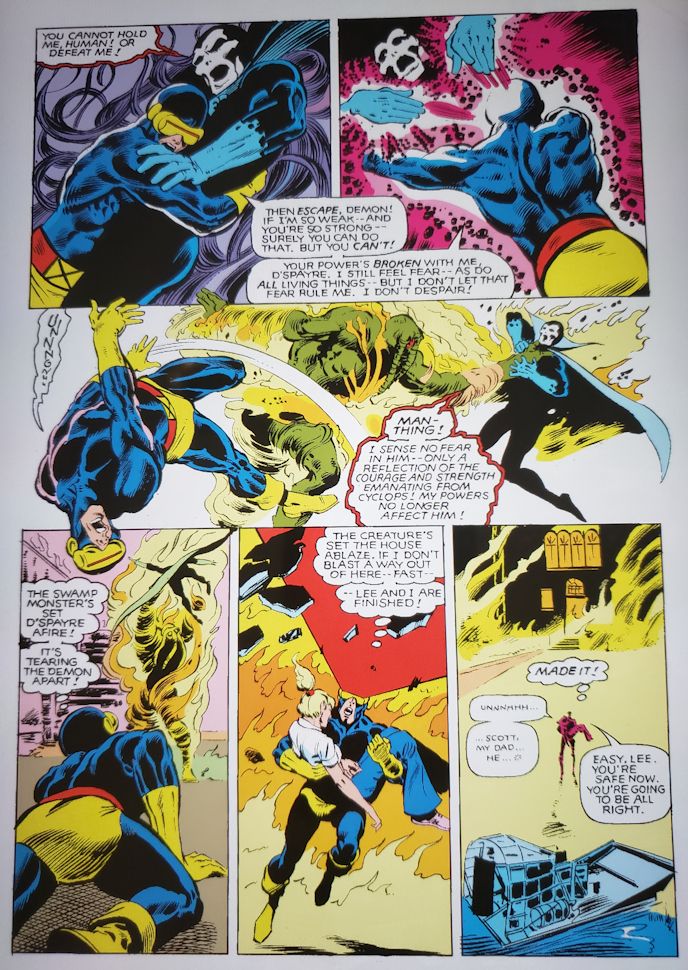
D“Spayre is the perfect villain to use against Scott, but it would only work at this specific time. At this point, Scott is still grieving over the death of Jean Grey, and he“s still uncertain about what to do with his life now that she“s gone. Up until now, Scott has been doing what he usually does to deal with painful emotions””shut himself off, focus on other tasks, and repress his true feelings. The presence of D“Spayre forces Scott to deal with those emotions, finally confront those feelings he“s been burying. Scott cannot defeat D“Spayre by himself, but he can help the Man-Thing, who does have the power to fight the demon. For Scott, the opponent isn“t the demon, but his own grief and pain, the things he left the X-Men to escape. Although the issue doesn“t deal with Scott“s issues as deeply as it could have, it does strengthen his relationship with Lee, and it moves Scott closer to the next phase of his life. It“s not one of Claremont“s best, but it accomplishes what it needs to and it works as a single-issue story.
This leads into the new X-Men“s first encounter with my favorite villain in comics. Mind, it isn“t surprising that Chris Claremont would begin his second run with Dave Cockrum with an encounter with Doctor Doom. Likely many reasons drove this decision, some of them creative. Firstly, by his own admission, Claremont was a fan of the Fantastic Four since the classic “Coming of Galactus”“ storyline, and Doom is the FF“s most iconic and complex villain. Doom presented the X-Men with a challenge they hadn“t faced before, one that would test them in an entirely new way. It would also give Storm her biggest test as a leader up to this point, giving her a highly intelligent and dangerous enemy to test her wits against. Beyond that, Doom is also a villain that makes fans take notice, and pitting him against the new X-Men would draw attention to the book“s new direction. All this meant that Dave Cockrum arrived on the book with a large splash and a renewed interest in what was coming up for the X-Men.
Doom is also a villain that is designed to work as a villain for nearly any kind of hero, and the X-Men are no exception to that. In some ways, he even works better away from the Fantastic Four, where he“s not caught up in his rivalry with his hated arch-rival, Reed Richards. At these times, Doom is usually far more focused on his objectives, less prone to falling prey to his worst impulses (such as his arrogance and pettiness), and thus a far more formidable threat. Doom is an intellectual enemy who tends to think moves ahead of his opponents, but he“ll also be more prioritized on his goals, which usually focus on his country of Latveria or upon conquest of the world. These kinds of stories, away from the FF, tend to focus more on Victor Von Doom as a sorcerer or the king of his nation, and less upon revenge schemes against his most hated enemies. While there are many excellent Doom stories as an FF antagonist, there are just as many great Doom stories that don“t feature the Fantastic Four at all, like Triumph & Torment. Doom is the rare villain that isn“t tied to his usual adversaries, and he doesn“t even need to play the role of villain at all. This allows Doom to be whatever the story needs him to be, and this easily allows him to be a good X-Men villain for this kind of story arc.
This story also marks the return of Arcade, and the setup for this story largely mirrors that of their previous encounter. Miss Locke, Arcade“s associate, kidnaps several of the team“s friends and family members, including Illyana Rasputin (Colossus“s sister, at that time a six-year-old girl), Jean Grey“s parents, Moira MacTaggart, Stevie Hunter, and Amanda Sefton. Instead of throwing them into Murderworld for Arcade“s amusement, Miss Locke decides to hold them hostage in exchange for the X-Men“s cooperation. She reveals to Storm that Arcade is being held prisoner by Doctor Doom, and Locke wants the X-Men to free him from the Lord of Latveria“s imprisonment. If the X-Men refuse or fail to do so, the hostages will die.
The X-Men“s strategy meeting that follows is quite well-written and serves as an early insight into how the team gradually changes under Claremont. While the X-Men are forced to agree initially, Claremont takes an unusual route that can only be called an X-Men solution, at least at that time. Wolverine, as a trained spy, knows that if the X-Men give into Miss Locke“s demands, they“ll be owned by Arcade. At the same time, Storm refuses to abandon the hostages or place them at further risk. Ororo“s solution is a reasonable one””take her team to Castle Doom to rescue Arcade, while an improvised team of former X-Men will infiltrate Murderworld and save the hostages. To this end, Xavier recruits Banshee, Havok, Polaris, and Iceman, leaving Banshee in charge of the mission. It“s a good way to use these forgotten characters and making them feel like part of the X-Men family, while also serving the larger story.
Ororo“s plan appears to go well, at least at first. Her initial plan for dealing with Doom is to send herself in as a diversion, negotiating with Doom while the remaining X-Men find and rescue Arcade. It“s a fairly basic plan that might have worked against most other villains but Doom, and Doom even admits as much once the cards are laid upon the table. From there, the situation quickly goes wrong for the X-Men, since Doom has anticipated such an attack, and the team is quickly captured. Arcade is revealed to be more an involuntary “guest”“ than a prisoner, and the encounter proves to be little more than a game between the two villains. Storm moves to attack Doom, who uses a device to transform her into organic chrome, rendering her an immobile captive.
At this point, it is worth mentioning that this is the second noteworthy time that a villain takes romantic interest in Storm. Previously, we“d seen this during the Arkon encounter, but we see it again during the “diversion”“ with Doom. This is a trope that Claremont tends to fall back on occasionally, though nothing seriously comes of it on any of these occasions. It may be that Claremont likes to humanize his villains by tempting them with his heroine, or he“s tempting Storm with the power and authority that the villain possesses. Likewise, this trope tends to play into one of Claremont“s strongest themes with Storm, the idea of freedom against confinement. One possibility may be that Claremont is threatening Storm with romantic confinement; if she accepts the villain“s offer, then she chains herself to the villain by the relationship, as she submits to his control. Storm is a wild, elemental character, representing the power of nature and the earth underneath her mask of serenity. She can never accept the villain“s offer in her heart, because that would not make Storm true to herself or her own convictions. Her heart must always be free, and any attempt to confine her is something Ororo naturally resists and reacts against.
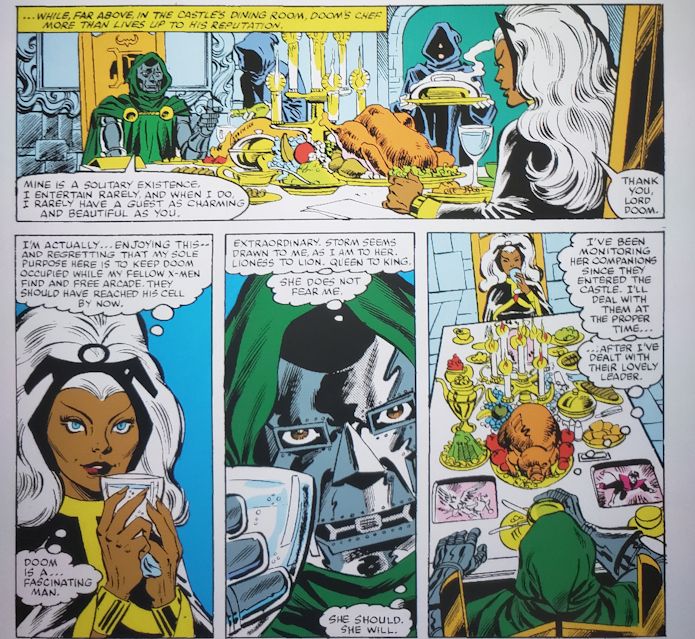
Although Doom makes precautions and plans for the X-Men very carefully, he does not have a deep understanding of Ororo“s true nature or her powers. Outwardly, Storm presents herself as the earth mother, the bringer of soft rain and gentle winds. It“s likely that this is the Ororo that Doom sees, and what initially enchants him. She is regal and she shows respect to Doom even as she plots to undermine his hold over Arcade. Later, he believes that Storm is defeated by his device, not realizing that he“s only unleashed the primal and elemental side of Ororo. This becomes more and more powerful the longer she“s confined, until her power can no longer be denied. It“s a good way of slipping a small detail past a highly intelligent enemy like Doom, as he“s not familiar enough with the X-Men to plan against this.
Claremont likely had read Lee and Kirby“s early Fantastic Four run, and he may have had those early stories in mind when setting up Doom“s traps for the X-Men. In those FF stories, Doom would construct his traps around his opponents, playing to their weaknesses. Doom tends to avoid simply killing his enemies, preferring to toy with them, especially those he doesn“t fully respect or view as true threats to him. He also likes to show off his intellectual superiority over his enemies, and that also shows itself in his idea of trap design. In this case, Doom may also have done this out of hospitality, viewing Arcade as a guest, and thus preferring to use the X-Men as a way of entertaining his guest. Interestingly, Doom admits to Arcade that he designed methods of escape, provided that the X-Men use their resources to find those openings. He clearly views this as a game, not taking the X-Men as serious opponents here.
Claremont borrows the Lee/Kirby method, designing traps around the X-Men“s powers and personality flaws. Nightcrawler is trapped in a featureless room, unable to get in or out except by a blind teleport. Wolverine is bounced from wall to wall in a room filled with psychedelic lighting that triggers his berserker rage. Colossus is trapped on a rock above water, targeted by lasers that will fire upon him if he attempts to escape. Angel is trapped on a perch that leads into a laser-filled maze, where the slightest mistake will kill him. At first, the X-Men are hesitant about how to approach these traps, and Claremont allows them room to dwell on it while he focuses on the secondary X-Men.
If there“s a flaw in this story arc, it“s that Banshee“s team has a relatively easy time of their rescue mission. Some of this might be forgivable if only because Arcade was not directly involved in the Murderworld subplot, and that Miss Locke has no reason to suspect an attack from Banshee“s group at first. Even so, this encounter lacks the challenge and the sense of menace that the X-Men dealt with during their first encounter with Arcade. It may be that Claremont or Simonson wanted a quick resolution for Uncanny X-Men #146 so as not to take too much space leading up to #150. In any event, it has the unintended effect of diminishing Arcade and Miss Locke as opponents. On the positive side, however, the mission is entertaining to watch, especially as drawn by Cockrum, and it“s good to see Banshee, Havok, Polaris, and Iceman in a Claremont story.
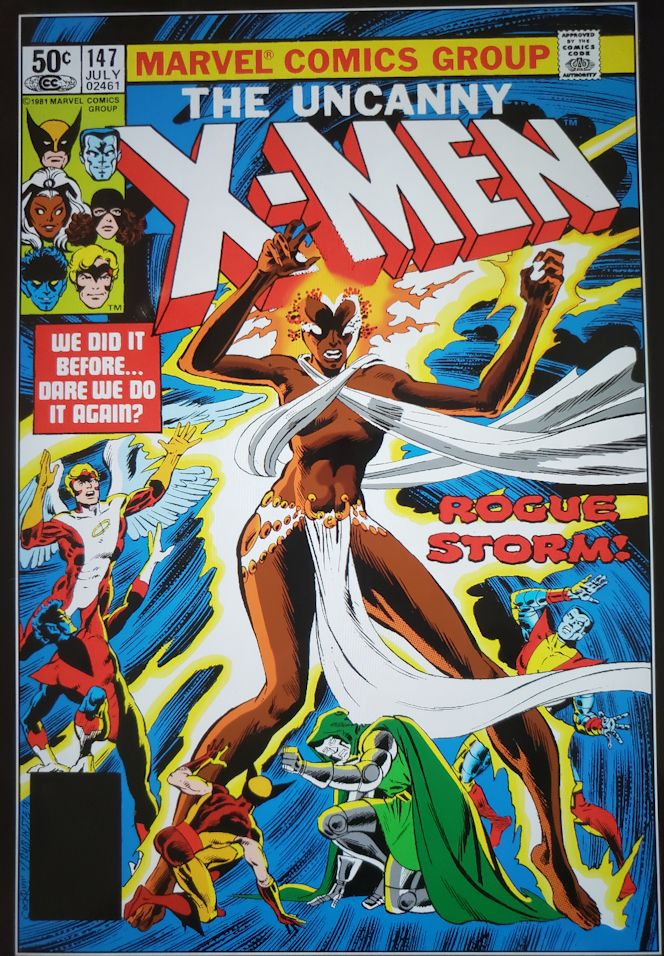
The cover to Uncanny X-Men #147 is a clever one, as here they are capitalizing on fan expectations after the Dark Phoenix Saga. One point that Claremont mentioned in the documentary Chris Claremont“s X-Men is his admission about how they would use that ending to their advantage around this time. The cover“s tagline proudly proclaims: “We did it before”¦ dare we do it again?”“ Because they had succeeded in shocking their audience with Jean“s death, now they had the license to threaten other characters in dramatic ways. Claremont never actually did kill anyone, but for many years until Jean“s resurrection, the threat of death had real weight. This is one of many reasons why Jean“s return was a short-sighted decision on Marvel“s part, but we“ll return to that question at another time. For now, the threat on Storm“s life was real because Claremont had already killed two X-Men before this, and Jean“s death had proven he could kill major characters the fans had attachment to.
The resolution in #147 is far better handled than the Murderworld subplot, and it“s clear that Claremont is much more interested in the A-plot with his main characters. The catalyst begins with the disappearance of Nightcrawler, who“s teleported out of his prison. He escapes death by teleporting above Castle Doom, using his powers and skills to find his way safely down into water. It“s an effective solution, allowing Kurt to display his wit as well as his acrobatics, and it“s an exciting scene as drawn by Cockrum. The remaining X-Men eventually find their own ways out of their prison traps, though most of them are not nearly so interesting and exciting as Nightcrawler“s.
The one exception is Wolverine, where his solution is built from gradual character growth since the start of the Byrne era. In the early days, Logan would have been more likely to lose control and lash out, but that would have gotten him killed in this instance. Against Doom“s trap, Wolverine instead decides to control and channel his rage, use the psychedelic lightshow to fuel his anger and focus it against strategic targets. This is a move that“s far more expected of Cyclops than Logan, and it might be that Logan learned some lessons in control from his old rival, loath though he“d likely be to admit this. Logan is not quite yet the samurai he would become a few years down the road, though this scene is an important stepping stone along that path.
The X-Men once more face Doom directly, and they succeed in freeing Ororo from her living prison of organic chrome. Here again, Claremont echoes the Dark Phoenix Saga, as Storm loses control of her own elemental powers. By this time, Ororo“s anger over her confinement has reached its boiling point, her claustrophobia and her fear fueling her anger at Doom. However, Ororo has lost all sense of her normal self-control, her power causing destruction on a massive scale because of Doom“s imprisonment. Eventually, Claremont would develop the relationship between these two aspects of Storm””the regal earth mother and the wild, elemental goddess””but this would be the initial catalyst. Eventually, this would lead into arguably Ororo“s greatest period as a character, as her arc would transform her from a goddess into a powerless but strong leader.
In the end, Storm is saved from herself by an impassioned plea from the kind, gentle Colossus, who reminds Ororo that she“s walking the same path as Dark Phoenix. Although Peter is not the smartest member of the team, he is capable of simple wisdom, and he offers compassion and truth. It“s also important that Ororo hears the truth from someone she regards as family, such as her “little brother”“ Peter. For all his massive strength, Peter is a very grounded character, as he provides a pillar of emotional support to his friend. Once again, Claremont raises the specter of Dark Phoenix, reminding the reader of how far he is willing to go to tell a story. However, it“s a point that remains universal with the X-Men, that any of them can lose control of their gifts, and that it“s their friends that provide balance and self-control.
The resolution ends well enough for the X-Men. Doom allows the X-Men to leave with Arcade in peace, provided restitution is made by Arcade. The X-Men force Arcade to make amends with Doom, Arcade is returned to Miss Locke, and the hostages are safely returned. The only exception to this is Illyana, who remains at the X-Mansion in the care of her brother Peter. It may be that Claremont already had plans to develop Illyana into Magik by this point, perhaps because Dave Cockrum wanted to draw the character. In any event, the B-team of X-Men return to their normal lives, and they largely wouldn“t be seen again for quite a few years.
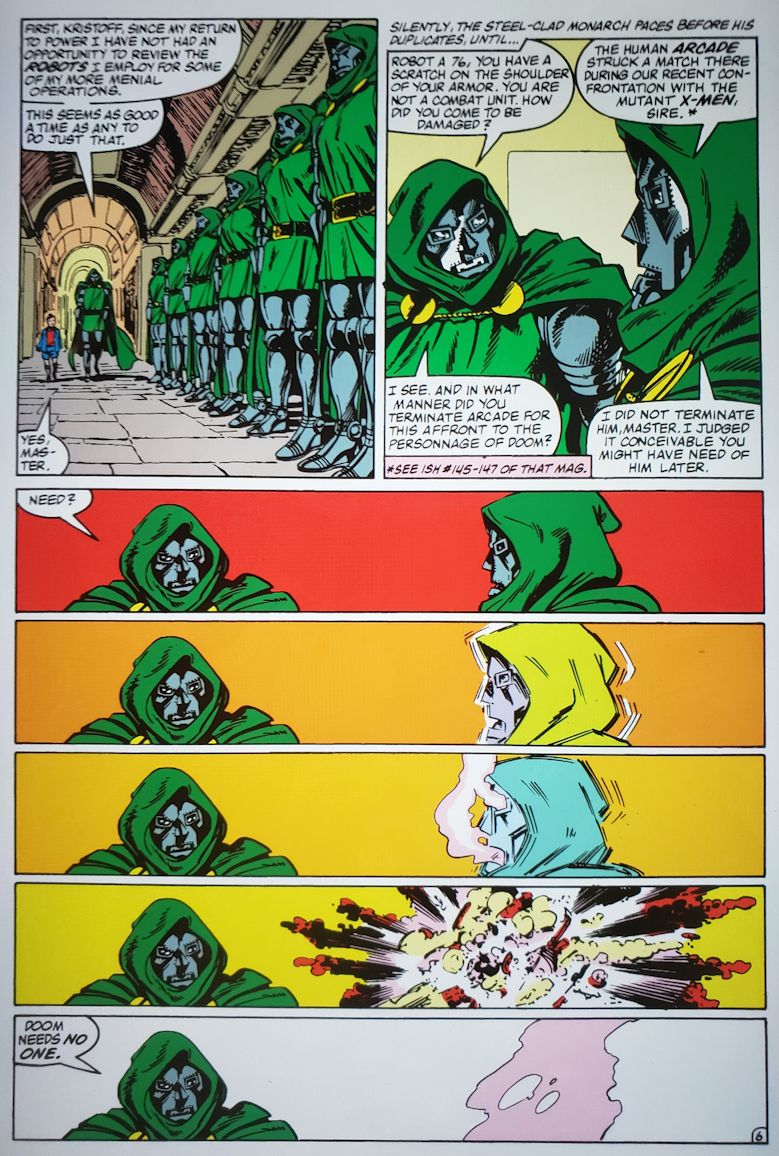
On a final note regarding the Doom storyline, this story was another incident between Chris Claremont and the departed John Byrne. Early in the Doom arc, Claremont wrote a scene where Arcade lit a match against Doom“s armor. Seeing this as an affront to Doom, Byrne eventually decided to retcon the Doom in this story. The “Doom”“ that faced the X-Men would be revealed to be a Doombot in Fantastic Four #258 and then destroyed by the real Victor Von Doom. This is a regrettable decision on Byrne“s part, since it undoes an otherwise excellent Doom story, and it also undermines Doom“s newly formed dynamics with the X-Men. One might imagine how this story might have affected Claremont“s later Doom stories had it been allowed to stand, had Byrne left well enough alone. As it is, however, this retcon is a relatively minor disappointment and a consequence of writers with different priorities working within a shared universe.
Uncanny X-Men #148 is largely about setting pieces in place for the confrontation with Magneto for the #150 event. Because of Storm“s imprisonment by Doctor Doom, Ororo subconsciously triggered a freak storm that hit Lee Forrester“s ship, the Arcadia. This leads to Scott and Lee washing up ashore by themselves on Magneto“s island. It“s here where Dave Cockrum“s skill at design comes into play, because it effectively shows how bizarre and Lovecraftian the island truly looks. Magneto did not create the island city; he found it and used it to its purpose. As Claremont would show in later issues, however, it“s a city with far older and far darker origins, though he mostly hints at them rather than directly explains them. Likewise, Cockrum effectively gets across the stunned and horrified reactions of Scott and Lee as they realize where they“ve been stranded.
It“s also a scene where Claremont lays down the status of Scott and Lee“s growing relationship. It“s again that the development feels rushed, though Claremont uses time jumps to attempt to justify Scott“s willingness to move on. In fairness, it does show that Scott has not completely moved on from Jean, and he struggles with the idea of being with Lee this soon. Still, once again, this is the weakest part of this entire Magneto arc, mainly the result of unexpected changes in plans.
Back at the X-Mansion, Claremont does a bit of housecleaning, starting with removing Angel from the X-Men. The justification that“s built for Angel“s departure is his growing distrust and dislike of Wolverine, and his disagreement with Xavier and Storm in keeping Logan on the team. This seems somewhat of a forced decision, especially since Logan and Warren were rarely shown in direct confrontation during their time together on the team. However, it seems like a decision built upon behind-the-scenes concerns. Angel was brought back during John Byrne“s tenure, and Byrne had only recently left the book a few issues ago. It may be that Claremont was picking his lineup according to what Dave Cockrum wanted to draw, and perhaps Cockrum had no desire to draw that character. In addition, Angel always was a fill-in character brought in to replace Scott, who would return with #150. It could just as easily be that Claremont had no need for Angel with Scott due to return with the big event. Whatever the reason, Angel would not be seen again in Uncanny X-Men until Paul Smith“s tenure as series artist.
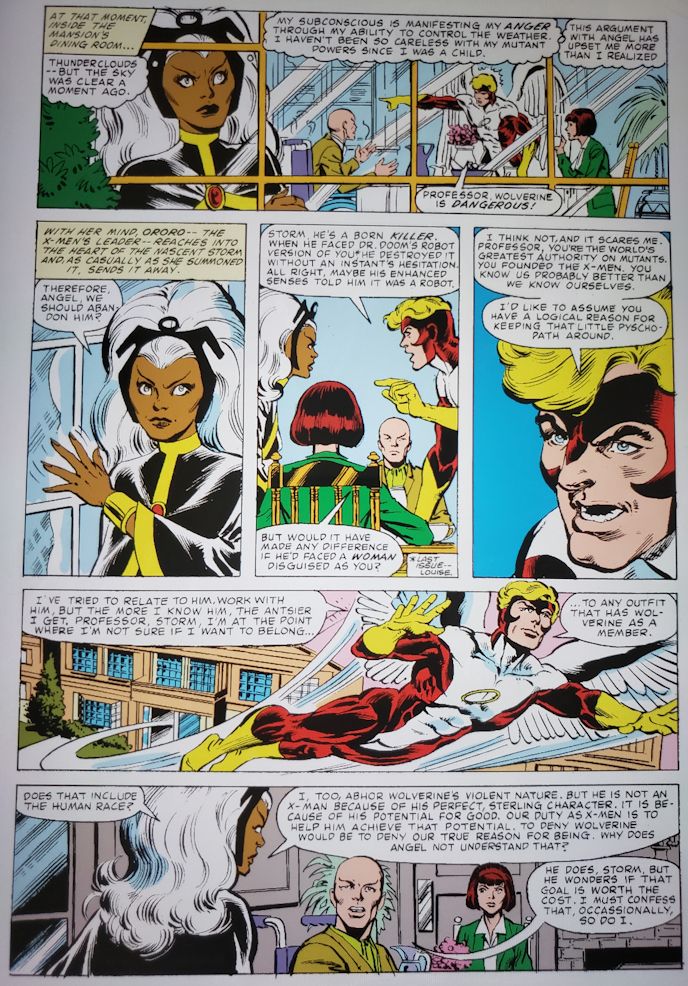
Banshee and Moira do not return to Muir Island immediately after the Murderworld rescue mission. Claremont uses his brief remaining time with them to clear up a loose end from Spider-Woman, which he was also writing around that time. In that title, Claremont had created Siryn, who turns out to be Sean Cassidy“s daughter Theresa. Claremont spends a couple of scenes in showing the family reunion between Sean and Theresa, as well as Moira“s reservations about the newfound relationship and her own issues about motherhood. These are strong, well-told scenes, but unfortunately nothing really comes of these moments after this.
Even more regrettably, Claremont sends Siryn back to Muir Island with her father, rather than developing her further with the X-Men. It seems odd that Claremont didn“t have her join the team around this time; the X-Men weren“t a particularly large group at the time, and there was no reason she wouldn“t have been accepted into their ranks. Siryn also would have added another strong female character to the roster, which was always Claremont“s biggest strength as a writer. While it may be that Claremont simply didn“t have plans for Siryn, it looks like a missed opportunity for her to be a more significant character. Siryn would turn out to be a much bigger player later in X-Force and in Peter David“s second run on X-Factor, but it would take many years before Siryn would get a real chance to shine.
The remainder of the issue deals with the X-Men, Dazzler, and Spider-Woman facing the Morlock named Caliban. The Morlocks wouldn“t be revealed in their entirety until some time later, and at times they don“t seem like a fully-formed concept in this issue. Caliban is motivated by loneliness and a desire to connect with others, so much so that he kidnaps Kitty in desperation. However, that seems like an unlikely reaction if Caliban was already living with Callisto and the other Morlocks. It seems more plausible, then, that the Morlocks hadn“t been fully designed by this time, and Caliban was Claremont“s first real attempt to deal with the idea of mutants being outcasts of society. He may have been feeling out his early thoughts on the Morlocks through this story, then fleshed them out later, perhaps with the input of Louise Simonson.
The result is a story that is something akin to Beauty & The Beast or Phantom of the Opera, featuring a misunderstood monster driven by love. Caliban is a different case than these examples, as he isn“t truly monstrous in his heart and he“s more just a miserable lost soul than a prince. Moreover, Caliban isn“t driven by a deep love built on understanding and a real connection with another person, but an obsession built upon loneliness and a low sense of self-worth. He was abandoned by his parents and named for a Shakespearean monster. Because of his appearance and his past rejection, Caliban doesn“t think he can truly be loved. He doesn“t truly know Kitty enough to love her, and he doesn“t have the social skills to interact with other people. Caliban is not a villain, but a misunderstood mutant who deserves compassion, and in many ways, he is the kind of person the X-Men should be trying to save. It“s the X-Men“s realization of this that ends the hostilities, paving the way for future encounters with Caliban and the Morlocks in the future.
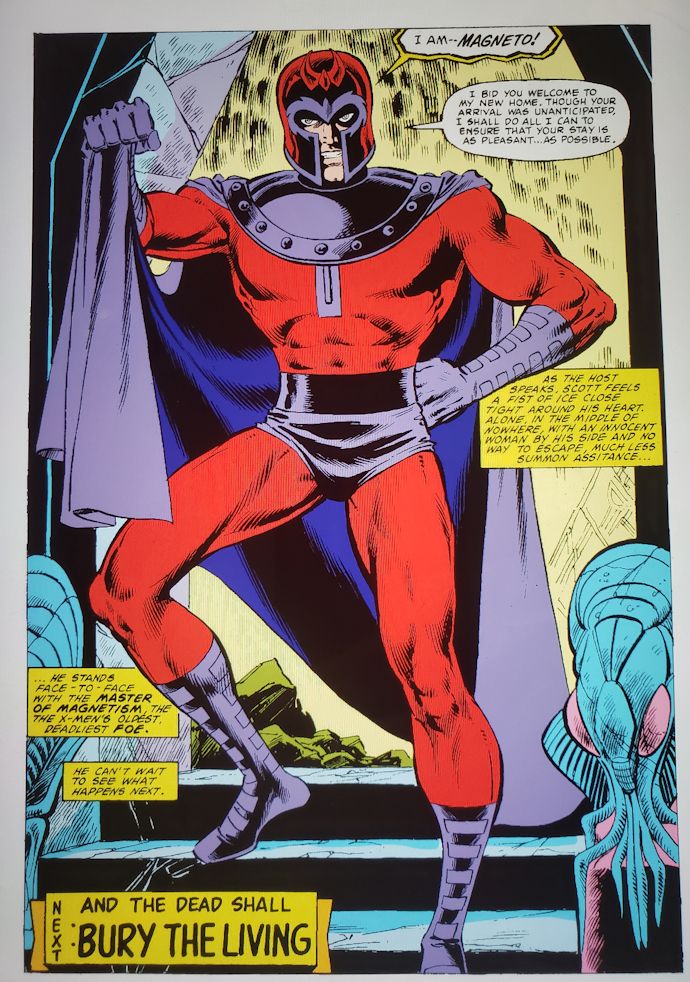
The issue ends with the arrival of Magneto, who announces himself to Scott and Lee Forrester. This is an intense cliffhanger panel, and Dave Cockrum does an excellent job at making Magneto look dignified, threatening, and imposing. The story also leaves a fair amount in the dark about Magneto and his plans, raising the question of whether he actually recognizes an uncostumed Cyclops. Without his visor or backup from the X-Men, Scott truly feels isolated and alone against the team“s most implacable enemy. This is a scene that leaves a strong amount of tension between issues, and the anticipation for #150 likely was powerful by the time this issue landed.
The following issue sends the X-Men on the trail of Magneto, but not before they contend with the return of Garokk, the Petrified Man. The last time that the X-Men had faced Garokk, Storm had failed to save him as he“d seemingly fallen to his death. Ororo still carries the regret of her decision that day, and it haunts her for much of this issue. She eventually does come to terms with it by the end of the story, mainly by confronting Garokk once more.
Meanwhile, Kitty stows away aboard the Blackbird, even though she was expected to remain behind at the mansion. Kitty is a character who spends much of her early time with the X-Men in a state of flux between student and X-Man, never quite being either. Her frustration with this would eventually cause her to directly oppose Xavier, but this is the issue where it begins. In fairness to the X-Men, she does act more immature than usual in this story, and she doesn“t yet understand the larger stakes of what the X-Men are fighting for. Still, both Kitty and the older X-Men struggle with Kitty“s status, whether she“s a student trainee or an X-Man with the same status as the rest of the team. To some extent, Claremont may not have known himself by this time; the New Mutants wouldn“t exist for at least another year, and there were no solid rules about who qualified as a full X-Man.
Garokk is eventually defeated, and Kitty makes the largest difference in the encounter. She“s forced to make mature decisions quickly, using her intelligence rather than her wisdom to solve the problem. The resolution does seem somewhat convenient, since Garokk is inexplicably vulnerable to Kitty“s phasing power. Still, she does grow up quickly in this issue, coming up with an actual plan to defeat Garokk on the fly. At the same time, Ororo also faces one of her largest regrets and makes a certain level of peace with it, especially knowing that Garokk was not in fact truly killed. As a whole, this issue is relatively forgettable aside from Kitty“s terrible wardrobe, though it does advance Kitty and Storm somewhat.
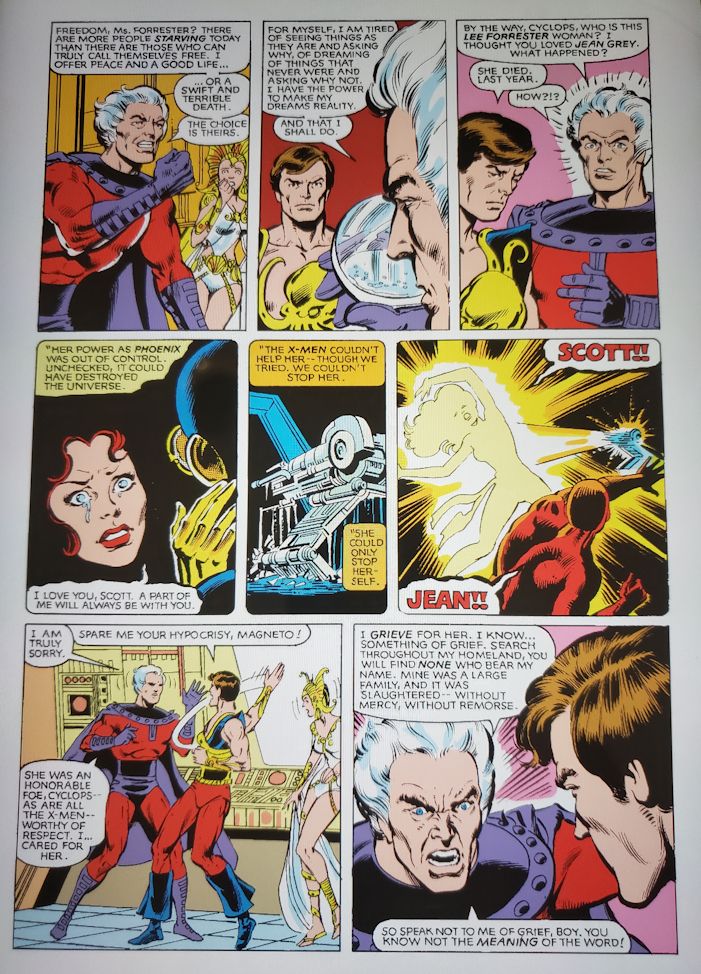
Chris Claremont“s true vision for Magneto was born in Uncanny X-Men #150. Claremont“s ideas were profoundly shaped by his time in Israel, which he visited briefly in his college years. These experiences likely led to his interpretation of Magneto as a Jewish Holocaust survivor, someone who had endured unimaginable horrors at the hands of the Nazis. Rather than being simply a Silver Age villain who hated the X-Men for opposing him, this Magneto was a wounded victim who foresaw a war with humanity for the fate of mutantkind. Claremont likely also imagined his friendship with Charles Xavier around this time, as there was no prior relationship between them back in the Silver Age. While all these are retcons and inventions, these are changes that added to the character of Magneto and created arguably the definitive version of an iconic villain.
Moreover, Claremont imagined a Magneto who turned away from the path of villainy, one that struggled to remain on the lighter path. We“d already seen hints of this in Days of Future Past, where the Magneto of the future was firmly on the side of the X-Men. It was never explained why that future Magneto was working with the heroes, but it may be that Claremont always intended this story to be that of Magneto“s redemption. This issue changed the course of the character from villainous conqueror to haunted, tormented anti-hero, and it was largely a benevolent change.
Magneto sets his plans into motion in the issue“s early pages, deciding to hold the world hostage with the mutant equivalent of nuclear blackmail. He threatens the governments of the world with annihilation unless they renounce all nuclear armaments and comply with his terms. Magneto“s justification for this is that nuclear weapons threaten all life on Earth, including his own kind, and he will not tolerate such a threat to mutantkind. When pressed on the point by Cyclops, Magneto desires for the money used on nuclear weapons to instead be used to end social problems like hunger, disease, and poverty. Rather than a direct plot to rule the world, Magneto is acting to protect his own kind, threatening the governments of the world to take action on his terms. While a bit of an overly optimistic hope on Magneto“s part, it is a scheme that is different from his usual plans up until now.
What follows is one of the darkest moments of Claremont“s tenure, and one that follows Magneto until Claremont leaves the book. The Russian government decides to retaliate against Magneto, ordering the submarine Leningrad to attack the island with nuclear ballistic missiles. Magneto stops the attack effortlessly, using his magnetic powers to stop the missiles and hurl them into the ocean. From there, Magneto responds with even greater fury, sinking the Leningrad to the bottom of the ocean and murdering all hands on board. Furthermore, Magneto decides to make an example of Russia by destroying the city of Varykino with a doomsday weapon. These two horrific crimes, though meant to protect mutants, have terrible consequences for Magneto in later years, beginning with his trial before the World Court.
Cyclops can do nothing to prevent any of this, since Magneto has enabled a device to nullify all mutant powers except for his own. He can only watch helplessly, try desperately to reason with Magneto, and his every attempt to do so fails. By this time, Scott doesn“t even have the advantage of surprise, since Magneto recognized him at the end of the previous issue. Still, he refuses to surrender to Magneto, remaining determined to stop him no matter what the cost. He shares an intimate moment with Lee before taking his stand against the Master of Magnetism.
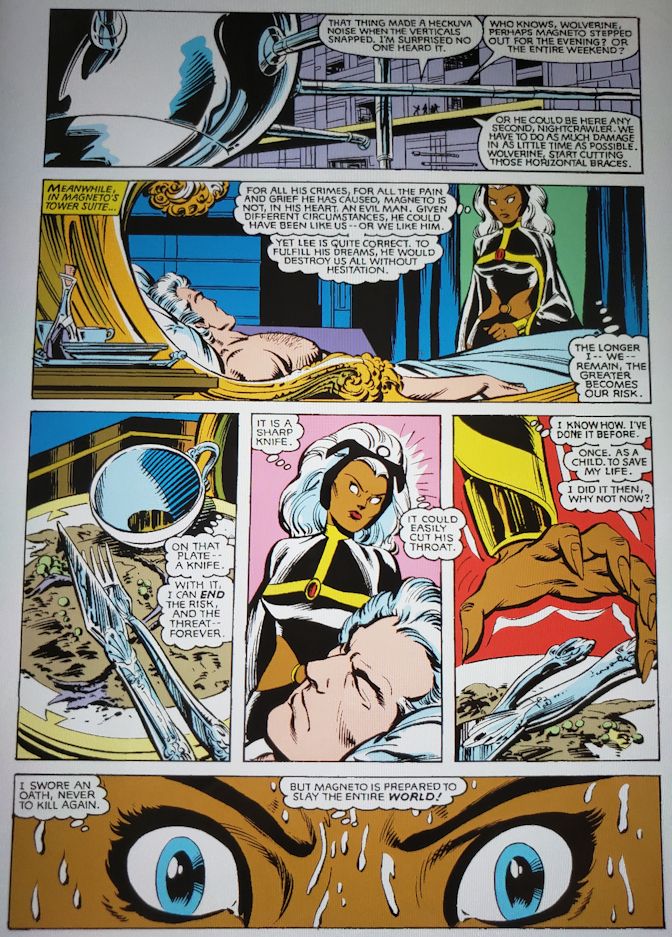
Fortunately for Scott, he isn“t alone, as the X-Men have found the island. Because of the devices Magneto had set upon the island, the X-Men are forced to make an emergency landing and abandon the Blackbird jet. Moreover, now that they“ve reached the island, the X-Men are affected by Magneto“s inhibitor field and lose their powers as well. This creates an even more challenging situation, with the X-Men forced to battle their greatest foe without the benefit of their powers. Still, with Scott“s leadership and the skills of each of the team members, they work out a plan to defeat him. To do this, they split up, with Scott“s team assigned to destroy Magneto“s doomsday weapon and Ororo“s team sent to investigate the computers.
Along the way, Ororo encounters a sleeping Magneto, and it“s here that her values are once again severely tested. Leadership has already put a strain on her morally, but now she“s forced to consider a much darker question. She could easily kill Magneto in his sleep and potentially save countless lives from what the arch-villain might do. However, to do so would be dishonorable and a betrayal of Ororo“s oath never to take another life. For a moment, Ororo considers it, wielding a knife with the thought of killing Magneto, but she decides against this, choosing to spare him. At that moment, Magneto awakens, sees Ororo holding the knife, and shuts her down almost instantly, seemingly killing her. He then escalates the battle, defeating most of the X-Men and taking prisoners, including Xavier, Kitty, and Lee.
The tide is finally turned when Storm, believed to be dead by Magneto, destroys one of the main computer terminals. While it seems an unlikely gambit and a convenient resolution, it deactivates the inhibitor field and restores the X-Men“s mutant powers. This allows the X-Men to attack Magneto and release his magnetic hold of the prisoners. This also proves to be a convenient diversion for Kitty, the one X-Man that Magneto does not yet know and who now has free rein through the entire complex unnoticed. Realizing this, Scott sends Kitty to destroy the remaining computers, thinking that the computers are necessary for precise targeting of the doomsday weapon. Kitty succeeds in her mission, but this attracts the attention of Magneto, who very nearly kills her.
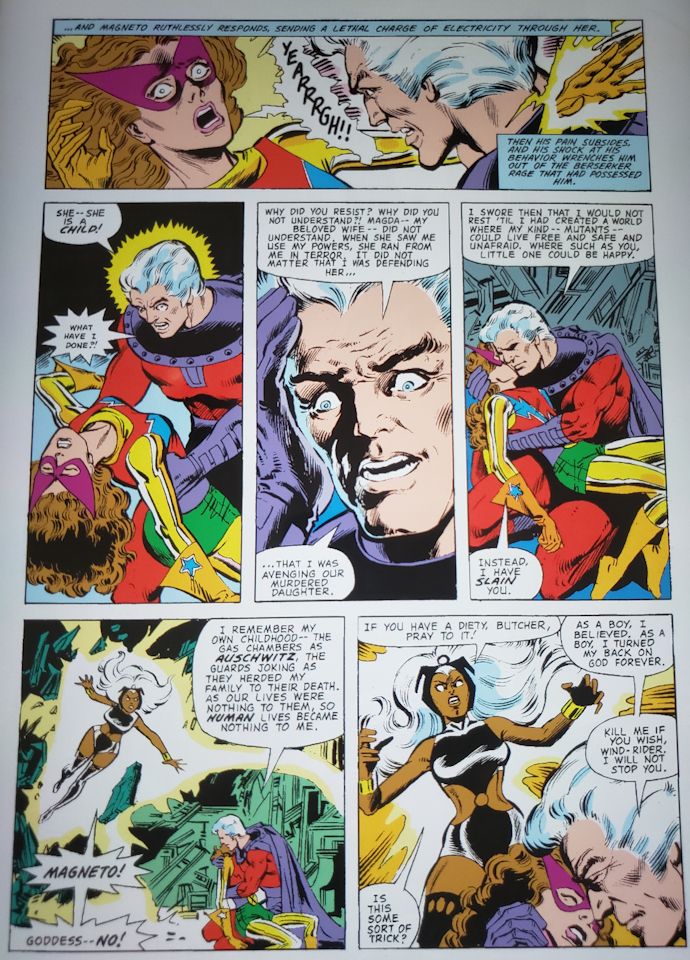
Magneto“s realization that he nearly murdered a child causes him to have a villainous breakdown and he stands down from fighting any longer. While Claremont“s idea for changing his mind with a dramatic example has some merit, the execution could have been slightly better told in this instance. The story asks the reader to accept that Magneto would suddenly show remorse at the idea of killing a mutant child, but this doesn“t quite connect with his history. Magneto seemed to have no problem with killing children in the past, most notably with the original X-Men, who were barely older than Kitty at the time. Granted this was the Silver Age, long before the idea of connecting Magneto to the Holocaust became a part of the character, but it is an oversight.
However, there are points that make Magneto“s sudden change more palatable in retrospect. Kitty may have reminded Magneto of his young daughter Anya, who he had previously failed to save as a younger man. He was deeply affected by her death and may have seen Anya in Kitty, realizing that he might have killed a child like his own. This was an element that was added later, developed more concretely in a Classic X-Men backup story, but it does help to explain his actions. That said, the scene would have worked better had Magneto realized that Kitty was Jewish, as he would have seen kinship with her and realized that he had killed someone who suffered from the same injustices that he lived through. Strangely enough, Kitty is the X-Man who is most like Magneto, as she“d also lost family members to the Holocaust; Claremont would reinforce this idea much later, after Magneto was fully reformed and working with the X-Men. If Magneto had seen Kitty“s Star of David necklace, for instance, it would have made much more sense for him to change the way he did. Ultimately, Claremont“s mistake with this ending wasn“t so much with Magneto“s sudden realization that he was wrong, but simply in the execution and the way Magneto“s remorse was triggered.
Uncanny X-Men #150 is a flawed Magneto story, but one that defined Claremont“s direction for the character for decades afterward. The flaws aren“t excessively deep, in fairness, and Claremont and Cockrum generally make it entertaining and insightful. However, it“s the full introduction of Magneto“s Holocaust backstory and the beginning of Magneto“s redemption arc that make it truly memorable. Magneto would disappear for some time, making his return later in the classic God Loves, Man Kills, while the X-Men would take temporary residence on the island. However, the X-Men had much more to endure until then. Next time, we“ll look at fairy tales, the return of some classic Claremont villains and the introduction of a fan-favorite X-Man.
Author Profile
- Steve Sellers had been a fan of superheroes ever since Superman: The Movie. But it took the JSA, the Legion of Super-Heroes, Dragonlance, Lord of the Rings, Twilight Zone, and Chris Claremont's legendary run on the X-Men to make him a writer and a longtime fan of comics, fantasy, and science fiction. Steve is the co-creator of WHITE DRUID & MICHAEL NERO and GUARDIANS OF ELAYIM for Omen Comics, and he is also the creator of BLITZ and SHOCKWAVE for Revelation Comics (an imprint of Omen Comics).








